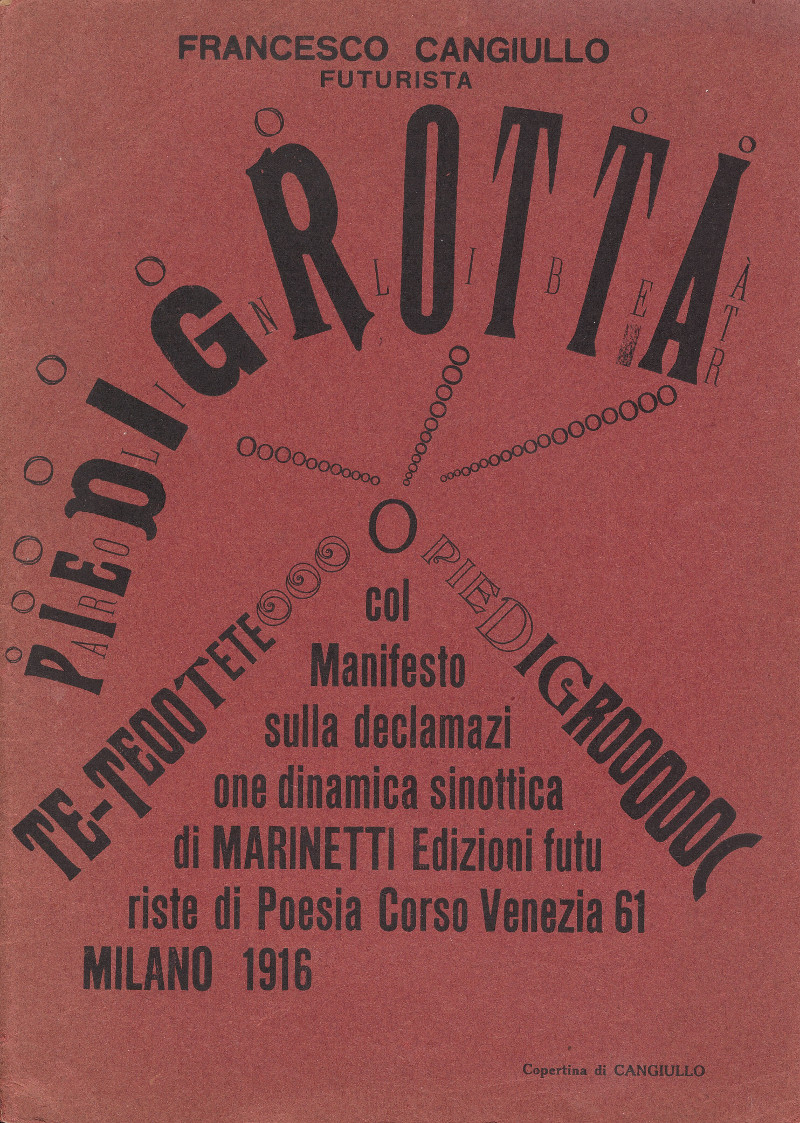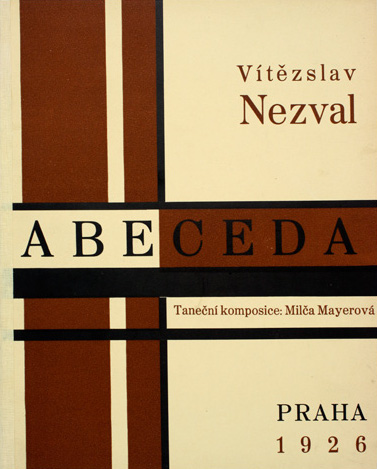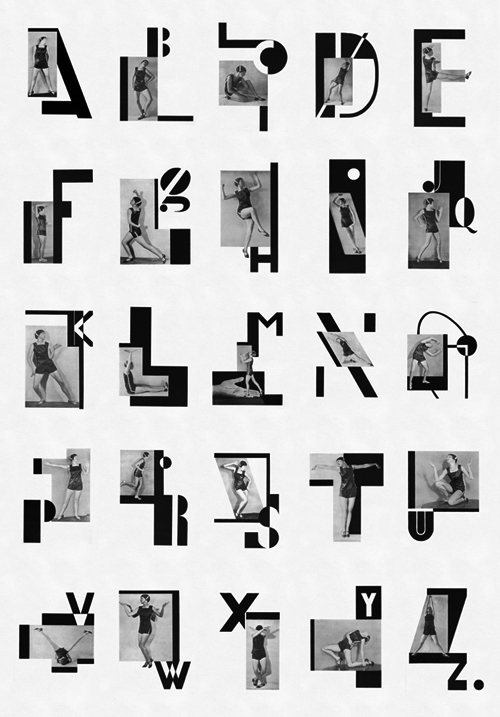Francesco Cangiullo: Piedigrotta (1916) [Italian]
Filed under artist publishing | Tags: · futurism, poetry, visual poetry

“Francesco Cangiullo, from Naples, was essentially a comedian; his theatrical attitude towards life that turned whatever he did into a performance. For this reason, Cangiullo could have equally well been a Futurist, a Dadaist, or a Surrealist. Indeed, in 1916, Cangiullo’s writings were published on the pages of the Zurich Dadaist journal Cabaret Voltaire. This volume featured many “words-in-freedom” of hilarious and ludic tone, with a dramatic and almost surrealistic bend. Cangiullo’s Piedigrotta: Manifesto on the Dynamic and Synoptic Declamation theorizes a kind of robotic and syncopated declamation.
The title and cover illustration, Piedigrotta, come from an annual Naples folk tradition, a pyrotechnic feast with extraordinary fireworks. These elements suggest the explosive thrust of Mt. Vesuvius, the volcano that stands over the gulf of Naples. Futurist evenings were also explosive. Originally introduced as literary and artistic evenings, they often turned into riots with people fighting, screaming and throwing all kinds of objects onto the stage. Cangiullo’s Piedigrotta features both explosive content and form.” (Source)
Piedigrotta: col manifesto sulla declamazi one dinamica sinottica
Publisher Edizioni Futuriste di Poesia, Milan, 1916
28 pages
via Beinecke Rare Book & Manuscript Library
Commentary: Mladen Ovadija (2013).
PDF (127 MB)
Comment (0)Vítězslav Nezval: Abeceda (1926)
Filed under artist publishing, poetry | Tags: · alphabet, avant-garde, dance, photography, poetry, typography

“In Nezval’s Abeceda, a cycle of rhymes based on the shapes of letters, I tried to create a ‘typofoto’ of a purely abstract and poetic nature, setting into graphic poetry what Nezval set into verbal poetry in his verse, both being poems evoking the magic signs of the alphabet.” – Karel Teige
The 1926 book Abeceda [Alphabet] is a landmark work of the artists’ collective Devětsil, active in Prague and Brno in the 1920s.
“The composition of Abeceda took place in three stages. Vítězslav Nezval wrote the poem in 1922 along the line of the grade-school syllabary, matching each letter of the alphabet with a single rhyming quatrain. Nearly every verse takes its lead from the visual aspect of its letter and proceeds as a sequence of fanciful associations: “A / let us call you a simple hut / Transport your tropics to the Moldau, o palms / A snail has its simple home with feelers sticking up / while people don’t know where to lay their heads.” For a celebratory Nezval evening in 1926 at the Liberated Theater in Prague, Milča Mayerová contributed a choreographed alphabet that complemented each quatrain with a sequence of poses. The composition concluded with Karel Teige’s addition of photo-montages that join photographs of Mayerová’s embodied alphabet with his own geometric letterforms.
Nezval’s verses follow from his conviction that poetry, as a game of language played at the level of its rudiments, provided a means of transforming the world directly. The photos of Mayerová illustrate in concrete terms this intimacy between language and reality; the poses have her almost trying the alphabet on for size. Teige’s photomontages organize that alphabetized figure with geometric letters according to the structure of the grid, which the artist regarded as an emblem of rational order. In setting Mayerová’s figure in gridded relation to the alphabet, Teige seemed to be insisting that readers consider the realities of life in relation to letters whose shapes they not only determine, but that in turn determine them.” (Source)
Abeceda. Taneční komposice Milči Mayerové
Publisher J. Otto, Prague, 1926
Illustrated with 25 black and white photomontages
57 pages
via V&A
Video adaptation (8 min, 2000, made at the Wolfsonian-FIU, Miami)
PDF (with Nezval’s poems in Czech, low resolution)
PDF (images only, low resolution)
Johanna Drucker: Diagrammatic Writing (2013)
Filed under artist publishing | Tags: · book, diagram, gestalt theory, graphic design, text, writing

“This is a book that is as close as possible to being entirely about itself.”
Diagrammatic Writing is a poetic demonstration of the capacity of format to produce meaning. The articulation of the codex, as a space of semantically generative relations, has rarely (if ever) been subject to so highly focused and detailed a study. The text and graphical presentation are fully integrated, co-dependent, and mutually self-reflexive.
This small book work should be of interest to writers, bibliographers, designers, conceptual artists, and anyone interested in the meta-language of diagrammatic thought in graphic form.
Edited, written and designed by Johanna Drucker
Online edition: /ubu editions, Visual Writing series
Printed edition: Onomatopee, Eindhoven; Cabinet Project, 97
Creative Commons BY-NC License
32 pages
via UbuWeb
Commentary: Johanna Drucker (New Formations, 2013), Johanna Drucker (Iowa Review, 2014).
PDF (updated on 2018-12-31)
Comment (0)

